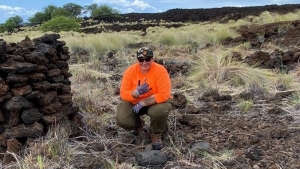
An anthropology student at the University of Hawaiʻi at Hilo, who came to Hawaiʻi from California to learn more about her Kānaka Maoli heritage, has developed a passion for history and preserving culture.
Heather Leilani Kekahuna grew up in Orange County, far away from her Hawaiian roots.
“My grandfather is originally from Olowalu, Maui, but grew up in Papakōlea on Oʻahu,” she said. “When he joined the military, my grandparents moved to the continent. It was there that my father met my mother…I wasn’t raised much around the Hawaiian culture.”
According to family, Kekahuna’s grandfather was a fluent ʻōlelo Hawaiʻi speaker. Her grandmother, also Hawaiian, was born on Kauaʻi and raised in Nuʻuanu, Oʻahu (where she still resides in good health at 88 years old). Kekahuna remembers hearing Hawaiian words here and there, during their brief encounters.
After graduating from high school, she enrolled as a history major at community college in Palm Desert. Her anthropology professor convinced her to shift her focus. “I kept doing projects based on Hawaiʻi and Hawaiian culture and so she asked me why didn’t I come to Hawaiʻi to learn,” she said.
Wahi Kupuna internship

Kekahuna moved to Hawaiʻi in 2017 to attend Honolulu Community College, and participated in the Wahi Kupuna Internship Program. The program, supported with funding from Kamehameha Schools, is open to undergraduate students in any of the 10 UH campuses enrolled in anthropology, archaeology, Hawaiian studies or a related field. During the program, interns engage in place- and community-based cultural resource management projects on Kauaʻi, Oʻahu or Hawaiʻi Island (where Kekahuna interned).
Through Wahi Kupuna, Kekahuna “started to learn so much, including some knowledge that was lost and I was able to regain again.” She added, “I’m now teaching things to my own family, my father and niece, and strengthening family ties through knowledge.”
Thriving Vulcan
After earning her associate’s degree from Honolulu CC, she enrolled at UH Hilo in the fall of 2019 and has been a thriving Vulcan ever since.
“The university resides on Native Hawaiian land, and that’s how it gave me the tools to connect me to the right people, the right programs and the right classes,” said Kekahuna. “The university helped ground me, immersing myself into the community and its culture.”
She recently wrote a blog post for the Hawaiʻi Historic Foundation highlighting her anthropological field research. The piece speaks about her quest to be more educated on Hawaiian culture and the community connections that have helped strengthen those efforts.
Museology and Miloliʻi

A large part of the article has to do with a project for her museology class. The budding researcher describes a serendipitous moment that led her to find a single box of fishing artifacts in the anthropology department’s collections room. These possessions came from the only remaining fishing village in Hawaiʻi, a place called Miloliʻi.
Kekahuna writes, “It was wonderful because prior to this finding, I was intent on building my connections with Miloliʻi and the community I come from. I was getting to know the place my Tūtū Kilikina was from and it became of personal importance to take on this project.”
She believes that this project was just the beginning—a stepping stone on the way to her future goal of becoming a secondary school teacher.
“As a Hawaiian, I feel like it’s expected of me to be here, to teach, to participate in anthropology. I should know that connection to the ʻāina,” she said. “The anthropology department has led me to finding out my identity and what it’s like to give back to the kupuna.”
—By Kiaria Zoi Nakamura, a UH Hilo student

